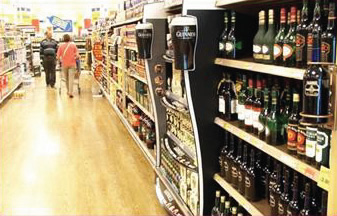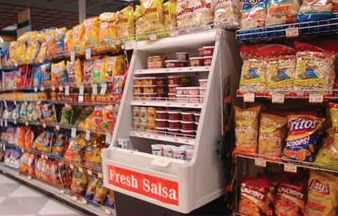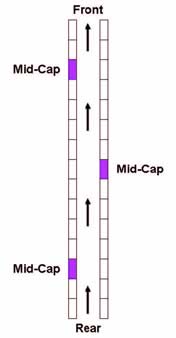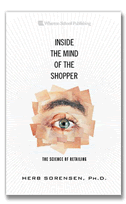End-caps are the powerhouses of any store, generating 20% of all store sales and featuring only 1% of the SKUs. The conventional wisdom is that products on end-caps sell more because they feature lower prices and reach a much higher number of shoppers than other locations. (Glen Terbeek, author of The Agentry Agenda, reported that half the people buying from a promotional display were unaware that the price was reduced, and of the half who were aware, half of those didn't care about the price reduction.) Because retailers can't duplicate the prime real estate of end caps in the middle of the store, they rely on copious sales signs to drive sales. But there are more fundamental reasons that end-caps work that retailers can use in a "mid-cap" center of the aisle display.
The two merchandising displays below have helped those brands break out from the pack to increase sales. The Guinness Stout on the left, for example, enjoyed a 23% sales lift over a six month period, while at the same time stimulating a 4% lift for the adjacent beer!


These "Mid-Cap" displays work for two reasons end-caps also work:
Simpler Selection:
Shoppers value time and ease of shopping. Can I quickly get what I need, without the angst of selection? End Caps work, in large measure, because you are not faced with 15 different kinds of tortilla chips. The retailer has selected their recommendation for your convenience. The Guinness and Salsa offers are a deliberate way retailers make shopping selection quicker an easier for shopper by reducing choices. In the same way, a good waiter will recommend an entrée or a clothes sales associate will find the right pair of jeans for a customer. It's not about letting shoppers work it out themselves, leaving frustrated and weary. The "active retailer" makes recommendations and highlights one product from the hundreds of others. Help shoppers with mid-cap displays that narrow the selection and they'll re-pay you with more rings and more trips.
Visually Distinct:
End-caps also work because the product stands out from other products. There is a clear spatial separation from end-cap displays and adjoining merchandise, often by 7 feet (2 meters,) across an aisle to an adjacent end-cap. (The same can be said of floor displays and other creative uses of promotional space.) The shopper is not confused about where the offer begins and where it ends. This "demarcation of the offer" is very important in terms of communicating with shoppers. The Guinness signboards and refrigerated salsa case help separate the offer from the wall of shelving. Simply providing a wall of merchandise, even with a blizzard of discount or other tags, is not making a realistic offer. A cacophony of offers is essentially no offer at all. Remember, time is always working against you. The shopper does not want to be in your store! Help them get what they need, and get them on their way.

How many mid-caps might it be reasonable to place in an aisle? Based on the average walking speed of shoppers, and the likely acceptable length of time required to make a serious offer, three per aisle is most likely the optimum number. Coming into the rear of the aisle (the most common shopper entry direction,) place a mid-cap about 10 feet (3 meters) into the aisle, on the shopper's left side (on the right side of the aisle if you are looking from the front of the store down the aisle. Then one another 15-20 feet (5-7 meters) further toward the front, on the shoppers' right side, and after another similar distance, a final one on the shoppers left.
By simplifying the purchase decision with enticing, visually distinct displays of a discreet product set, mid-caps can provide a powerful lift in your center store.


